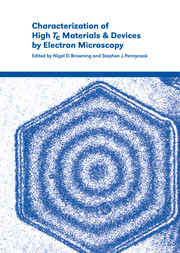Book contents
- Frontmatter
- Contents
- List of contributors
- Preface
- 1 High-resolution transmission electron microscopy
- 2 Holography in the transmission electron microscope
- 3 Microanalysis by scanning transmission electron microscopy
- 4 Specimen preparation for transmission electron microscopy
- 5 Low-temperature scanning electron microscopy
- 6 Scanning tunneling microscopy
- 7 Identification of new superconducting compounds by electron microscopy
- 8 Valence band electron energy loss spectroscopy (EELS) of oxide superconductors
- 9 Investigation of charge distribution in Bi2Sr2CaCu2O8 and YBa2Cu3O7
- 10 Grain boundaries in high Tc materials: transport properties and structure
- 11 The atomic structure and carrier concentration at grain boundaries in YBa2Cu3O7–δ
- 12 Microstructures in superconducting YBa2Cu3O7 thin films
- 13 Investigations on the microstructure of YBa2Cu3O7 thin-film edge Josephson junctions by high-resolution electron microscopy
- 14 Controlling the structure and properties of high Tc thin-film devices
13 - Investigations on the microstructure of YBa2Cu3O7 thin-film edge Josephson junctions by high-resolution electron microscopy
Published online by Cambridge University Press: 21 August 2009
- Frontmatter
- Contents
- List of contributors
- Preface
- 1 High-resolution transmission electron microscopy
- 2 Holography in the transmission electron microscope
- 3 Microanalysis by scanning transmission electron microscopy
- 4 Specimen preparation for transmission electron microscopy
- 5 Low-temperature scanning electron microscopy
- 6 Scanning tunneling microscopy
- 7 Identification of new superconducting compounds by electron microscopy
- 8 Valence band electron energy loss spectroscopy (EELS) of oxide superconductors
- 9 Investigation of charge distribution in Bi2Sr2CaCu2O8 and YBa2Cu3O7
- 10 Grain boundaries in high Tc materials: transport properties and structure
- 11 The atomic structure and carrier concentration at grain boundaries in YBa2Cu3O7–δ
- 12 Microstructures in superconducting YBa2Cu3O7 thin films
- 13 Investigations on the microstructure of YBa2Cu3O7 thin-film edge Josephson junctions by high-resolution electron microscopy
- 14 Controlling the structure and properties of high Tc thin-film devices
Summary
Introduction
The discovery of cuprates exhibiting superconductivity at relatively high temperatures has opened up new prospects for the application of superconductivity in many areas, in particular in sensor systems and in electronics [13.1, 13.2]. In this respect the superconducting quantum interference device (SQUID) is one of the most attractive developments. Many different designs have been fabricated and studied, and modern SQUIDs on the basis of YBa2Cu3O7 have reached field sensitivity and performance levels not far different from those known for devices produced with classical low temperature superconductors [13.3, 13.4].
The physical properties of cuprate superconductors depend sensitively on the preparation conditions and the resulting microstructure. Owing to the essentially two-dimensional superconductivity and the very small coherence length in the cuprates, grain boundaries in general reduce the critical current density by orders of magnitude compared with the bulk value. Therefore much attention has been paid to the development of techniques for growing high quality epitaxial thin films of superconducting and appropriate non-superconducting materials required for active and passive electronic devices on suitable single-crystalline substrates. The remarkable progress achieved is closely related to both the development of proper materials preparation techniques and high quality materials characterization. In fact, device production requires atomic or close to atomic structural perfection. High-resolution transmission electron microscopy, which developed atomic resolution in many materials during the early 1980s, i.e. shortly before the new materials were discovered, has contributed substantially to the understanding of the structural properties of cuprate superconductors and to their use in electronic devices.
Besides instrumental resolution, two important technical factors are decisive for the enormous potential of high-resolution electron microscopy for superconductivity research.
- Type
- Chapter
- Information
- Publisher: Cambridge University PressPrint publication year: 2000

